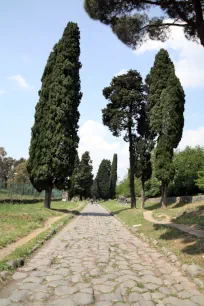Via Appia Antica (Old Appian Way) was once one of the world’s most important roads and the most famous of all the roads that radiated from Rome towards the far ends of the Roman Empire.
Building the Road

The Via Appia, originally built in 312 BC, was the brainchild of Appius Claudius Caecus, the then-censor of Rome, who was known for organizing bold public works that helped make life easier for the people of Rome. Appius Claudius’ most famous project was this road, which would eventually run all the way from Rome to the port city of Brindisi.


The road began as a level dirt surface upon which mortar and small stones were laid. On top of that, gravel was placed, topped with interlocking stones that would provide a flat surface for those traveling the road. Historians say the stones fit together so well that it was nearly impossible to stick a knife between them. Ditches were dug on either side of the road and were protected by retaining walls.
A 560 km long road
Via Appia began at the Circus Maximus, passing along the Baths of Caracalla, and later, the Aurelian Wall. Near Rome, the road was lined with tombs.
When the road left the city, it traveled through wealthy suburbs on its way straight through the Appian Mountains and over the former Pontine Marshes to Terracina, a coastal town 56 km south of Rome. From there, the Appian Way followed the western coast, eventually ending at Capua, making the original road about 210 km long.

This road achieved its goals by helping the Roman army move military supplies where they were needed in a quick manner, resulting in several victories for the army.
Sometime around 295 BC, the road was extended to Benevenutum and then, within the next five years, to Venusia and Tarentum. Eventually, the Appian Way made it all the way to the port city of Brindisi on Italy’s southeast coast, 560 km. from Rome (about 350 miles).
Monuments Along the Appian Way

Since it was forbidden to bury the dead in the city proper, many were buried along the roads leading out of Rome. Important people built tombs for themselves or for their whole family. These tombs were sometimes as large as a house. Their shapes varied from a tumulus or a pyramid to a small temple. The Via Appia was lined with such monuments, and many of them are still visible today.


The most impressive is the well-preserved tomb of Cecilia Metella – the wife of one of Julius Caesar’s generals, which looks almost like a fortress. Other notable tombs include the tomb of Marcus Servilius, the tomb of Romulus (son of Emperor Maxentius), the tomb of Seneca (a Roman philosopher) and the tomb of the family of Sextus Pompeius Justus; The inscription on the tomb tells of the grief of a father burying his young children. There’s also an emperor buried along the Via Appia, Gallienus, who was murdered in 268 AD.
Other Sights
Besides the numerous tombs along the road, there are some other monuments that line the Via Appia: the Temple of Hercules, the church Quo Vadis (where Saint Peter is said to have met Christ) and the remains of the Gothic church of San Nicola. The Villa dei Quintili, with its ancient baths and beautiful friezes and sculptures, is located nearby at the Via Appia Nuova. And nearby the tomb of Romulus is the Circus Maxentius, a large arena where chariot races were held. Adjacent to the circus was a palace built by Emperor Maxentius. The circus, which was second in size only to the Circus Maximus, is the best preserved of all Roman circuses.
Underneath
While the Via Appia is lined with monuments and tombs of ancient Roman patrician families, many find what’s under the Appian Way to be more interesting. Below the street are miles of tunnels – known as catacombs – where the early Christians buried their dead and, when necessary, held secret church services. Several of the catacombs are open to the public and on a guided tour led by local priests and monks, visitors can view ancient burial niches and a handful of remaining examples of early Christian art.

Walking along the Via Appia
Today, the Via Appia starts at the Aurelian wall, at the Porta San Sebastiano. The first part of the road is not exactly pedestrian friendly. It leads along the Quo Vadis church, the catacombs of San Callisto and the catacombs of San Sebastiano to the imposing tomb of Cecilia Metella. From here, the road is paved with the authentic Roman stones. You can walk for many kilometers, passing the remains of numerous historic tombs.

